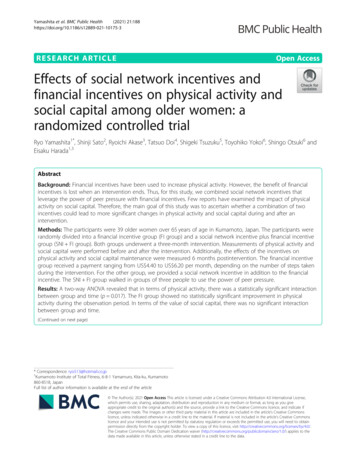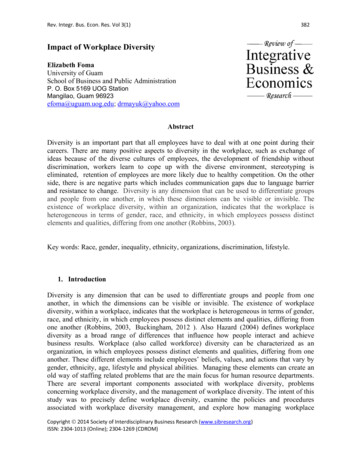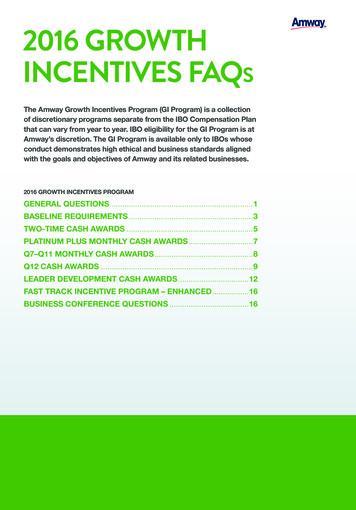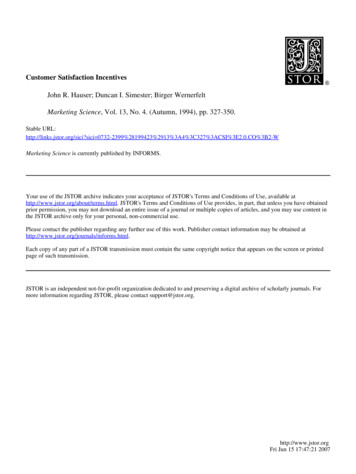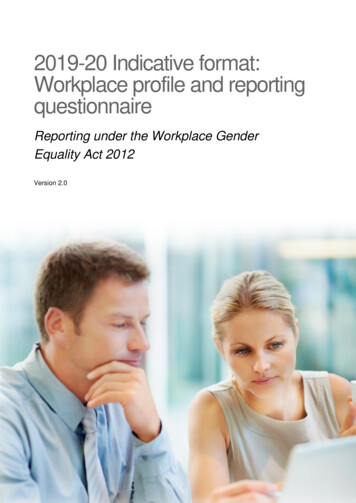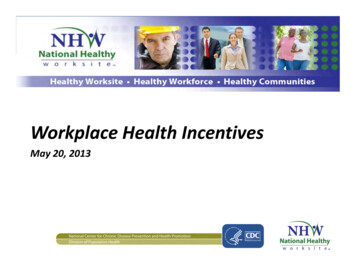
Transcription
Workplace Health IncentivesMay 20, 2013
Agenda Background and Issues– David Anderson, PhD, LP Opportunities and Challenges– Sharon Covert, MS Questions and AnswersDisclaimer: The findings and conclusions in this presentation are those of theauthor and do not necessarily represent the official position of the Centers forDisease Control and Prevention2
Objectives Describe the types and uses of incentives Designing an incentives based program Laws, Regulations and Ethical guidelines3
Incentive and Disincentives Incentive An anticipated positive or desirable rewarddesigned to influence the performance of anindividual or group.Disincentive An anticipated negative or undesirable consequencedesigned to influence the performance of anindividual or group.Source: WELCOA Absolute Advantage Magazine 2005 Vol. 4(7) www.welcoa.org4
Carrots and Sticks CarrotsCommonly viewed as positive rewards designedto influence the performance of an individual ora group. They are the most popular form ofincentives for workplace health programs. Theseinclude merchandise, health premiumreductions and cash.Sticks Disincentive commonly viewed as a negative orundesirable consequence designed to influencethe performance of an individual or group.These typically involve some sort of penalty suchas premium surcharges.5Source: WELCOA Absolute Advantage 2008 www.welcoa.org
Types of incentives Monetary6Non-monetaryMoney-based compensation such as:Prospect-based compensation such as: Cash Additional paid vacation Gift Cards Health Savings Account Contributions Premium Differential Verbal or visual recognition Coveted parking space/office space Flex time Flexible work schedules Merchandise Gym membership
Non-monetary Incentives Non-monetary rewards can be a cost effective way toincentivize employees and sustain an incentiveprogram over time. Programs with excellent non-monetary incentives canattract, motivate and retain participants. Employers typically rely on non-monetary incentiveswhen economic limitations make it difficult to offermonetary incentives, but they can be a part of anyworksite wellness design regardless of the economicsituation. Source: Society for Human Resources ts/Articles/Pages/NoncashMotivator.aspx7
Non-monetary Incentives Incentives coveted by generation– Traditionalists Flexible work hours Transportation benefits to and from the workplace.– Baby Boomers Paid tuition for college coursesContinuing education creditsGood retirement planFlexible work hours– Gen Y & Gen X 8New technologyRecognition such as plaques or employee of the monthContinuing education benefitsTickets to eventsMerchandise (e.g. t-shirts, gym bags, and coolers)Source: Society for Human Resources ts/Articles/Pages/NonfinancialRewards.aspx
Incentives Offered 42%Raffles/Drawings36%Gifts/Merchandise33%Gift CardPremium Discount26%Cash26%13%HAS/HRA/FSA Contribution12%Other9%Vacation/Paid Time Off8%Reduced Cost Share0%5%10%15%20%25%30%35%Percent of Employers Offering IncentivesSurvey of 300 employers with 500-10,000 employeesSource: Goldsmth C. Behavioral Economics Improve Workforce Health ts/articles/pages/behavioraleconomics health.aspx. January 3, 2012940%45%
Ways incentives can be used Participation-based incentives – financial incentive awarded for completing a taskor participating in a health behavior program. They are an effective way to gaininitial interest in a health program, but aren’t designed for extended behaviorchange, which requires continued commitment.– Example: Cash incentive or premium reduction for completing an annual health riskassessment or biometric screening Outcomes-based incentives – awarded for achieving a health standard based onspecific health outcomes. It is unknown if they will increase behavior change ortransfer costs from employees who achieve the health standards to those whodon’t.– Example: Premium reduction for attaining and sustaining target ranges for their BMI, bloodpressure and cholesterol levels. Progress-based incentives - awarded for making meaningful progress towardspecific health goals. In this way, a progress-based incentive model offers everyemployee an opportunity to earn the incentive by achieving tailored health goals—regardless of their current health status.– Example: An employee with a BMI of 40 setting a weight-loss goal of 10% of their body weightinstead of unrealistically trying to attain a BMI of 25 within a year.Source: Society for Human Resources cles/pages/healthincentives.aspx10
Employers Holding Employees Accountable 62% of employers plan on switching fromparticipation-based incentives to outcomes-basedincentives They view this method as a means to controlrising health care costsSource: Towers Watson Survey11
Employers Using Incentives and Disincentives 70%61%60%62%54% 50% 40% 30% 19%20%20% 18%10%0%Offer rewards/incentives for participationOffer penalties/disincentives for not completingrequirementsPercent201120122013*Survey of 583 employers with at least 1000 employeesSource: Towers Watson/NBGH Survey 2012 Reshaping Health Care: Best Performers Leading the Way12
Offering Incentives by Size of Employer 0%0%Jumbo (20K )13Large (5K-20K)Source: Nation Business Group on Health/Fidelity Investments Survey 2012Mid-Market ( 5K)20112010
Key Scientific FindingsAuthorFindingsO’Donnell MPAmerican Journal of Health Promotion (2010)There is minimal evidence that financial incentives havea direct impact on improved health behaviors.Dudley RA, et al.Agency for Healthcare Research and Quality Report(2007)Incentives have minimal sustained effects on smokingcessation or weight loss, but can increase participationin smoking cessation or weight loss programs.Paul-Ebhohimhen V and Avenell AObesity Reviews (2008)Financial incentives do not have a significant effect onweight loss or maintenance between 12 and 18months.Cochrane Collaboration Review (2011)Results and success from incentivized programsdwindled after rewards were dispersed, with theexception of one recent trial.Seaverson EL, et al. (2009)American Journal or Health PromotionSupportive culture and comprehensivecommunications increase incentive effectiveness.Volpp K, et al. (2009)New England Journal of MedicineIncentives up to 750 increased the rate of smokingcessation over 12 months.Volpp K, et al. (2008)Journal of the American Medical AssociationWeight loss during a 16 week intervention wasencouraged with economic incentives. These resultswere not completely sustained.Taitel MS, et al. (2008)Journal of Occupational and Environmental MedicineValue of incentives was a strongly tied to HRAcompletion rates.
Incentives and Smoking Cessation Of 878 participants, about half received incentives while the otherhalf did not. The incentives were 100 for completion of a smokingcessation program, 250 for cessation of smoking within 6 monthsafter study enrollment, and 400 for abstinence for an additional 6months after the initial cessation.– Smoking cessation was confirmed by cotinine tests The incentive group had significantly higher rates of smokingcessation than did the control group 9 or 12 months afterenrollment and 15 or 18 months after enrollment. Incentive-group also had significantly higher rates of enrollment in asmoking-cessation program, completion of a smoking-cessationprogram , and smoking cessation within the first 6 months afterenrollment.Source: Volpp KG, et al, N Engl J Med. 2009 Feb 12;360(7):699-709. doi: 10.1056/NEJMsa080681915
What are the benefits of incentives? Research shows that well designed worksite wellness programsare effective. Research also shows that 6 in 10 employees believe worksitewellness programs are a good idea. Of those who believeworksite wellness programs are a good idea, only 3 in 10participate in worksite wellness programs.1 Incentives can help lead to a change or maintain a change in thecurrent state of workplace health, help gain/ retain participationin a program, and support healthier behaviors.2Source: 1. WELCOA Absolute Advantage 2008 www.welcoa.org2. WELCOA Absolute Advantage Magazine 2005 Vol. 4(7) www.welcoa.org16
Why do employers use incentives? Promote learning Encourage participation in programs Encourage improvement in fitness and other testscores Encourage behavior changes in health service use Encourage compliance with professional health advice Encourage initiation and maintenance of specifichealth behaviors Encourage accomplishment of personal healthenhancement objectivesSource: WELCOA Absolute Advantage Magazine 2005 Vol. 4(7) www.welcoa.org17
What motivates employees? Intrinsic – taking action out of genuineinterest with no consideration of rewards,goals, or outcomes. Extrinsic – taking action for compensation orto avoid penalties.Source: StayWell Health Management, Making Wellness Rewarding Without Rewards, 2012 18
Intrinsic vs. Extrinsic Incentives have been shown to increase rates of simple behaviorsthat do not require sustained motivation. However, long-term behavior change requires sustained motivationfor an extended period of time. Significant amounts of external or “extrinsic” motivation maydecrease internal or “intrinsic” motivation. Extrinsic motivators, such as modest incentives, may help developintrinsic motivation by prompting employees to learn about healthand wellness, engage in wellness program components, and beginselected behavior changes.1 Research remains inconclusive regarding the effects of incentives onencouraging sustained health behavior changes.19Source: 1. Exploring the Role of Financial Incentives in Worksite Wellness Programs by Dr. Alan Balch, VP ofPreventive Health Partnership, April 10, 2012
Incentive or Disincentive Tied to Participation or Results Achieved 84%Health Risk Questionnaire70%18%64%Biometric screening53%37%Incentive39%Successful completion of lifestyle programs17%64%Neither42%Participation in lisfestyle modification classes21%61%40%Participation in fitness challenge4%64%PercentSource: Aon Hewitt 2012 Health Care Survey20Disincentive
Annual Incentive Values by Employer Size 2011 MedianIncentive45%40%Mid-Market 44515% 5K35%42%Large23%5-20K 30040%35%Jumbo25%20K 0%5%10%15% 25021 42520%25% 250-499Source: Nation Business Group on Health/Fidelity Investments Survey 2012 30% 50035%40%45%50%
Pros and Cons of Incentives Pros Can influence healthy behaviors Can be adjusted easilyEasy to implementMultiple rewards can be given Part of an overall engagementstrategyCons Difficulty choosing the reward youthink in right Chance of rewarding poor healthhabits May have unintendedconsequences Employees can abuse the system Employees become accustomed tothe rewardIncentives can be PART of your overall employee health strategy, but NOT thewhole strategy.Source: WELCOA Absolute Advantage Magazine 2005 Vol. 4(7) www.welcoa.org22
Summarizing Current Evidence Employers should carefully consider the pros and cons associated withincentives and disincentives.1 Behavioral economics research suggests that employees may work harderto stop loss than to make similar gains.1 Reward programs are more likely than penalty programs to convey aculture of shared accountability between employer and employee inseeking a mutually beneficial goal —employees' health.2 Determining which reward to use depends heavily on the company’sculture and leadership style.1 Incentives can be PART of your overall employee health strategy, but NOTthe whole strategy.1.Exploring the Role of Financial Incentives in Worksite Wellness Programs by Dr. Alan Balch, VP ofPreventive Health Partnership, April 10, 2012 2.Volpp KG, et al, N Engl J Med. 2009 Feb 12;360(7):699-709. doi: 10.1056/NEJMsa0806819 23
Characteristics of an Incentive-Based Program Integrates with other wellness program offerings Incentives tie to all program offerings Makes the goal of the program helping each participantearn the incentive reward Reduces program activity that is not connected to therequired behavioral activity Simplifies the range of wellness issues that the programusually addresses Streamlines much of the conventional wellness activity bylinking it to the reward Keeps the focus of the program positive and emphasizeshow to earn the reward Usually has a much more effective evaluation processSource: WELCOA Absolute Advantage Magazine 2005 Vol. 4(7) www.welcoa.org24
Guidelines for Incentive Based Program Design PlanningProcess EvaluationTransitionDesign ImplementationSource: WELCOA Absolute Advantage Magazine 2005 Vol. 4(7) www.welcoa.org25
Planning Process 26Consistent with and supported by the type of work culturePrior knowledge of incentives should be positiveExpectations should be clearThe purpose for the incentive program is logically supportableTime designated to implement the incentive programA simple set of rules needs to be augmented by a more detailed setof operating rulesPilot test the incentiveTest for the potential of system abuseTest for unintended consequencesMake sure rules meet HIPAA requirementsCreate the expectation that employees will become intrinsicallymotivated
Design 27Rewards used are highly valued by employees and large enough to motivate Market research is used to confirm the types and size of rewards to be used Multiple forms of rewards are betterEmployees deem reward requirement and required behaviors reasonableand attainableLimit the number of qualifying behaviors used in a major incentive program The behavioral requirements benefits to the employee should beemphasizedA “core” or major incentive program can be used over a long period of timeand augmented with short-term incentive featuresCare must be taken to avoid negative unintended consequences, such ashaving unlimited weight loss goals per week leading to an employee usingunhealthy methods to lose weight resulting in illnessProvide several ways of qualifying for each major behaviorLinked required behavior or criteria to the purpose of the incentive program
Implementation Rules of the incentive must be clear and easy to convey and understand The incentive program should be strongly endorsed by the most seniormanager Record keeping requirements should not be burdensome Multiple promotion opportunities of the incentive program work better Reminders are used frequently Reminders as to the individual’s status in more complex incentiveprograms are used at least every six months Provide some reward to those who don’t qualify for the big reward Reaction should be positive for the majority of eligible employees The shorter the time between the required behavior and the reward thebetter The reward is given when and how participants expect it Rewards are never eliminated after the qualifying behaviors have beencompleted Protective features are used to minimize “self-report errors” or scams28
Transition Make improvements and modifications eachcycle The new program is rolled out with some level offanfare Use an efficient and accurate record keepingsystem between cycles Adhere to the timeline Minimize intervals between incentive cycles Emphasis is continually placed on participatingand directed at non-participants29
Evaluation Annual evaluation of the incentive feature orprogram Clear goals of the incentive make for an easierevaluation process Use a consistent set of metrics that measurevarious aspects of the incentive’s performancefrom year to year Measure incentive’s economic return each year Issue a formal annual evaluation report each yearwith recommended modifications30
Considerations for Incentives Program Design Employees who work toward a goal but fall shortcan be treated the same as those who make noeffort. Significant incentives could be used as part of acost shifting and underwriting strategy. Employers ignoring employees’ physicianrecommendations when it comes to issues likeselecting an alternative standardSource: Exploring the Role of Financial Incentives in Worksite Wellness Programs by Dr. Alan Balch, VP ofPreventive Health Partnership, April 10, 201231
Increase in Employer Sponsored Insurance (ESI) forSingle and Family Employee ContributionEmployer Contribution 11,429 5,866 4,664 4,316 2,617 466 951Single 2002Single 2012 2,137Family 2002Source: Kaiser/HRET Survey of Employer-Sponsored Health Benefits, 2002–2012.32Family 2012
Impact of Increased Health Plan Costs Research shows that individuals sacrificeneeded health care because of costs associatedwith it. High health plan deductibles may lead to highermedical costs because cost-sharing may createobstacles to seeking preventive care anddisease management.Source: Hall, JP. Carroll SL. Moore JM. Health care behaviors and decision-making processes among enrollees in a statehigh-risk insurance pool: focus group findings. American Journal of Health Promotion. May/June 2010. 24(I)33
Public Health Service Act Nondiscrimination in Health Insurance “ a group health plan may not require any individual(as a condition of enrollment or continued enrollmentunder the plan) to pay a premium or contributionwhich is greater than [that] for a similarly situatedindividual enrolled in the plan on the basis of anyhealth status related factor [This rule] shall not prevent a group health plan fromestablishing premium discounts or rebates in returnfor adherence to programs of health promotion anddisease prevention.”Source: Public Health Service Act, Section 2703(b) 34
Genetic Information Nondiscrimination Act (GINA) Title II of GINA prohibits employers and other covered entities fromrequesting, requiring, or purchasing genetic information, subject to sixlimited exceptions. One exception allows a covered entity to acquiregenetic information about an employee or his or her family memberswhen it offers health or genetic services, including wellness programs, ona voluntary basis. The individual receiving the services must give prior voluntary, knowing,and written authorization. While individualized genetic information maybe provided to the individual receiving the services and to his or herhealth or genetic service providers, genetic information may only beprovided to the employer or other covered entity in aggregate form. The final rule of GINA for the Acquisition of Genetic Information makesclear that covered entities may not offer financial inducements forindividuals to provide genetic information as part of a wellness program.Source: http://www.eeoc.gov/eeoc/foia/letters/2011/ada gina incentives.html 06/24/2011 35
Guidance on GINA The Equal Employment Opportunity Commission(EEOC)’s guidance states: “Covered entities may use the genetic information voluntarilyprovided by an individual to guide that individual into anappropriate disease management program. However, if thatprogram offers financial incentives for participation and/orfor achieving certain health outcomes, the program must alsobe open to employees with current health conditions and/orto individuals whose lifestyle choices put them at increasedrisk of developing a condition.”Source: http://www.eeoc.gov/eeoc/foia/letters/2011/ada gina incentives.html 06/24/201136
Americans With Disabilities Act (ADA) Title I of the ADA allows employers to conductvoluntary medical examinations and activities,including obtaining information fromvoluntary medical histories, as part of anemployee wellness program as long as anymedical information acquired as part of theprogram is kept confidential and separatefrom personnel records.Source: http://www.eeoc.gov/eeoc/foia/letters/2011/ada gina incentives.html 06/24/2011 37
Guidance on ADA EEOC guidance states that a wellness program is“voluntary” as long as the employer neither requiresparticipation nor penalizes employees who do notparticipate. The EEOC has not taken a position on whether, and to whatextent, Title I of the ADA permits an employer to offerfinancial incentives for employees to participate in wellnessprograms that include disability-related inquiries (such asquestions about current health status asked as part of ahealth risk assessment) or medical examinations (such asblood pressure and cholesterol screening to determinewhether an employee has achieved certain healthoutcomes).Source: http://www.eeoc.gov/eeoc/foia/letters/2011/ada gina incentives.html 06/24/201138
HIPAA 2006 Wellness Provisions Wellness program categories:– Participatory Wellness Programs Made available to all similarly situated individuals and that either do notprovide a reward or do not include any conditions for obtaining a reward thatare based on an individual satisfying a standard that is related to a healthfactor1 Not required to meet five requirements outlined in the next slide1 Financial reward is not limited by HIPPA1 Commonly referred to as Participation-Based incentives2– Health–Contingent Wellness Program Require an individual to satisfy a standard related to a health factor to obtain areward (or require an individual to do more than a similarly situated individualbased on a health factor in order to obtain the same reward)1 Required to meet five requirements1 Commonly referred to as Outcomes-Based incentives2Source: 1. Federal Register Notice for Incentives for Nondiscriminatory Wellness Programs in Group Health -wellness-programsin-group-health-plans2. Noyce J, CEO of HERO. AHIP Fall forum 2012 Wellness Programs and Compliance considerations39
Overview of HIPAA Outcomes-Based Incentive Requirements 1. Total amount of incentives or penalties cannot exceed 20% of total costof employer sponsored insurance coverage (increases to 30% in 2014)2. Incentives can only be used as part of a wellness program that is“reasonably designed to promote health and wellness” 3. Opportunities to qualify for incentives given at least once per year4. Employers must offer a waiver or “reasonable alternative standard” if theemployee is unable to meet the standard due to a medical condition ordoctor’s recommendation5. Reasonable alternative standards or waivers must be defined inmarketing materials that contain incentive qualifications Source: Federal Register Notice for Incentives for Nondiscriminatory Wellness Programs in Group Health -wellnessprograms-in-group-health-plans40
ACA 2010 Raises the maximum premium discount differential thatis currently allowed under HIPAA for employees thatachieve specified health outcomes in accordance with aworksite wellness program (beginning in January 2014,increases to 30%, or up to 50% for employers offeringprograms that help prevent or reduce tobacco use) Clarifies how “reasonable designs” and “reasonablealternatives” to wellness programs should beadministered in order to avoid discriminationSource: Federal Register Notice for Incentives for Nondiscriminatory Wellness Programs in Group Health -wellnessprograms-in-group-health-plans41
ESI Wellness Program Incentives HIPAA Premium VariationAnnual Cost of ESI20%30%50%*Single 5,615 1123 1,684 2,807Family 15,745 3,149 4,723 7,872Source: Average premiums for single and family coverage in 2012 based on Kaiser/HRET Survey of Employer-Sponsored Health Benefits*Tobacco Use Prevention or Reduction Programs42
Areas requiring further interpretation Definition of “Health status factor” Defined standard for a “reasonablydesigned” wellness program or the“reasonable alternative standard” foremployees who cannot meet health metricsSource: 1. Noyce J, CEO of HERO. AHIP Fall forum 2012 Wellness Programs and Compliance considerations2. Exploring the Role of Financial Incentives in Worksite Wellness Programs by Dr. Alan Balch, VP ofPreventive Health Partnership, April 10, 201243
Joint Consensus The American Heart Association, the American Cancer Society,American Cancer Society Cancer Action Network and the AmericanDiabetes Association joined with the Health EnhancementResearch Organization (HERO) and the American College ofOccupational and Environmental Medicine to develop consensusguidance to employers, Guidance for a Reasonably Designed,Employer-Sponsored Wellness ProgramUsing Outcomes-Based Incentives– Joint consensus discusses suggestions for a reasonably designedprogram and a reasonable alternative standard for wellness programs This consensus was created to provide guidance to employersimplementing the proposed rules for Incentives forNondiscriminatory Wellness Programs in Group Health Plansreleased by the Internal Revenue Service, the Employee BenefitsSecurity Administration, and the Health and Human ServicesDepartment in the November 2012.Source: Noyce J, CEO of HERO. AHIP Fall forum 2012 Wellness Programs and Compliance considerations44
Proposed Rule Provisions forReasonably Designed Programs Created to promote and improve health orprevent disease Cannot be excessively difficult Cannot be a ploy for discrimination based on ahealth factor The program selected to promote andimprove health or prevent disease should bescience basedSource: Federal Register Notice for Incentives for Nondiscriminatory Wellness Programs in Group Health -wellnessprograms-in-group-health-plans45
Recommendations for Elements of a ReasonablyDesigned Wellness Program from Joint Consensus Strategic Planning Cultural and Organizational Support Programs for– Assessment and Screening– Behavior Change Interventions (programs, activities,information) Engagement Methods– Communications– Incentives Measurement and EvaluationSource: Noyce J, CEO of HERO. AHIP Fall forum 2012 Wellness Programs and Compliance considerations46
Proposed Rule Provisions forReasonable Alternative Standard Employers must offer a waiver or “reasonable alternativestandard” if health care provider ’s advisement or a medicalcondition prohibits the participant from achieving thehealth standard within the time assigned for the program– Employers can use the recommendations of an employee’shealth care provider for setting reasonable alternativestandard or providing a waiver for those with medicalconditions. Incentives must be offered to individuals who meetqualifications through the reasonable alternative standardSource: Federal Register Notice for Incentives for Nondiscriminatory Wellness Programs in Group Health -wellnessprograms-in-group-health-plans47
Recommendations for ReasonableAlternative Standards from Joint Consensus Create an incentive design that considers individualgoal attainment rather than “ideal” health targets.– Reward participants for progress toward the goals.– This may help individuals with higher health risks improvetheir general health and behavior incrementally. Alternative standard opportunities for attainingincentives can be provided to all employees ratherthan offering it only to those with a medical condition.– This can help those with afflictions, other than medical,that make it harder to attain a preferred health behaviorSource: Noyce J, CEO of HERO. AHIP Fall forum 2012 Wellness Programs and Compliance considerations 48
Recommendations for ReasonableAlternative Standards from Joint Consensus Ideally employers would create tailored,individualized programs that would helpemployees integrate behavior changeapproaches they deem valuable. This approachpromotes intrinsic motivation which results in agreater chance of sustained behavior changeover time.Source: Noyce J, CEO of HERO. AHIP Fall forum 2012 Wellness Programs and Compliance considerations49
Ethical ConsiderationsEthical ConcernMeasured targets are failures to takevoluntary actions to improve healthbehavior.Biometric outcomes are not the measuredtarget for penaltiesExampleExample: Employees received informationof health benefits of smoking cessation andencouraged take action and adopt changes.The measured goal should be taking action,such as not entering a smoking cessationprogram results in a penalty. Employersshould not measure strictly for the presenceof nicotine in the body. This would penalizethose making attempts to quick smoking.Example: Employees should not bepenalized for high cholesterol levels,because some are genetically predisposedto high cholesterolSource: Pearson S and Lieber S. 2009 Health Affairs. Vo l .2 8(38) DOI 10.1377/hlthaff.28.3.845 50
Ethical ConsiderationsEthical ConcernExampleNo discrimination:Transparency: selection process and Behavior selected leads to poor health justification for selection made public outcomes and increased health carecostsEvidence-based: behavior selection Selection not based on stigmatizationsupported by robust empirical data of the behavior or of individuals proneto the behaviorAccommodation for fundamental behavior Examples: child bearing, outdoor sports,and recreationSource: Pearson S and Lieber S. 2009 Health Affairs. Vo l .2 8(38) DOI 10.1377/hlthaff.28.3.845 51
Summary Creating a healthy culture and work environment is a fundamental best practicefor increasing employee participation leading to potential health improvement. Various types of financial and other incentives may
May 20, 2013 · WELCOA Absolute Advantage Magazine 2005 Vol. 4(7) www.welcoa.org . 16 : Why do employers use incentives? Promote learning Encourage participation in programs Encourage improvement in fitness
